Highlights
Table of Contents
Explore article topics
We’ve mentioned it plenty of times before – when it comes to YouTube SEO and getting more views, YouTube tags and keywords play a huge role. It’s essential to expand your knowledge of what tags and keywords do and why they’re so important. It will enable you to improve your video search rankings more than ever before. Naturally, with better search rankings come more views and, hopefully, more subscribers. Let’s dive into everything you need to know about YouTube keywords and YouTube tags.
What are YouTube keywords?
YouTube keywords are exactly that – keywords that you identify to associate with your video. For example, if I’m making a video about climbing an active volcano, my keywords may be “hiking” and “active volcano”. You want to select relevant, searchable words that will be your main focus. You’ll use these both in the title and the tags of your YouTube video.
What are YouTube tags?
YouTube tags are essentially just keywords for YouTube. They won’t show up in your video title or description, but there’s a dedicated space for them when uploading your video. It’s the same concept as YouTube keywords – you want to use searchable terms that are relevant to your video content.
Why are YouTube Keywords and YouTube tags so important?
YouTube keywords and search tags are crucial because they help the YouTube algorithms determine how good and relevant your content is to various searches. So, when people do a YouTube keyword search (for example, “hiking active volcano”), the algorithm analyzes your tags and keywords. If the tags and keywords are relevant and appropriate to the video content, YouTube will serve your video much higher in its search rankings.
Naturally, the higher you are in the search rankings, the better chance you have of earning clicks and views. But, of course, other things, such as knowing how to make a YouTube thumbnail, play into this. Still, the more exposure your videos receive in the search rankings, the better chance of more views and, hopefully, more subscribers. So, in short, they’re a big deal!
How do you find YouTube keywords and tags?
When looking at how to start a YouTube channel from scratch, you hopefully now understand why YouTube video tags are so important. The next step is understanding how you find appropriate YouTube keywords and tags for YouTube.
Competitor research
First up, if you’re serious about promoting YouTube videos properly, then I recommend doing some research on your competitors. What other videos are already out there that cover the same themes and topics as your video? Think about the topic of your video and what you would type in to find it on YouTube, then start searching those terms. For example, if it’s a travel video about road tripping around Bali, you may search for something like “the ultimate Bali road trip” and “Bali road trip”. Alternatively, if you’re looking to upload a video covering the best action cameras in 2024, you’d search for “best action cameras 2024” or “top 10 action cameras”.
Now, take a look at the top 10 to 15 highest-ranking videos on that search term. What are their titles like? What keywords are they using? What have they mentioned in the video descriptions? This is a really solid foundation for you to start identifying your YouTube keywords and search tags.
YouTube analytics tools
Next up, you can start using various YouTube tools to dig deeper on these tags. For example, TubeBuddy is a browser extension that really enhances your YouTube keyword search and the ability to identify YouTube video tags that will actually provide results. Simply go to their site, install the plugin (it’s free, with a paid premium option if you wish), then head back to YouTube. Now, when you’re carrying out video research, you’ll be able to see how well TubeBuddy ranks it.
For example, I searched for “the ultimate Bali road trip” and came across this video from Lost LeBlanc. To the right-hand side of the video, you can see the analytics TubeBuddy provides, including how well the various tags are performing in their search rankings.
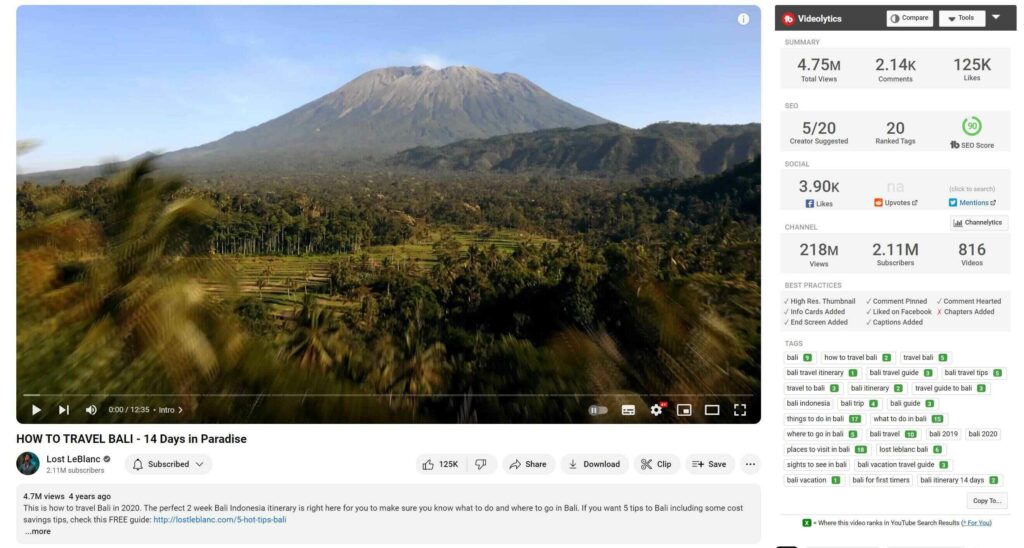
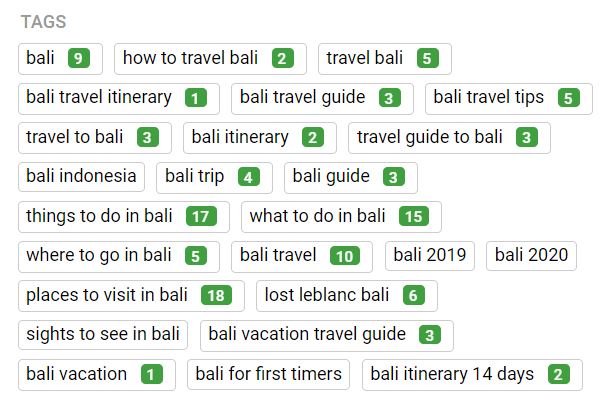
Similarly, you can find the same tools with the VidIQ plugin. To the right-hand side of the video I can see all of the analytics, including how well the various tags are performing in their search rankings.
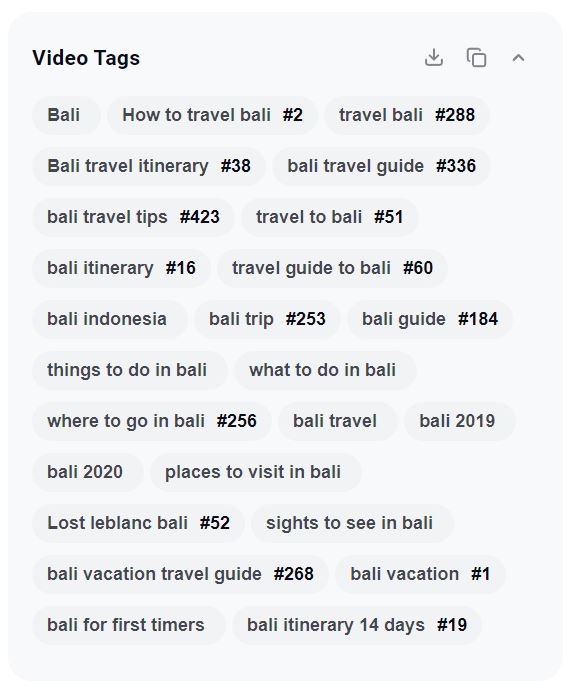
Interestingly, the two tools do differ on some of their rankings!
Generating YouTube tags
Next up, you can use these tools to come up with your own YouTube tags. With TubeBuddy, I can continue my competitor research by using the keyword explorer tool. To open this up, simply click the TubeBuddy extension icon in the top right-hand corner and navigate to “keyword explorer”.
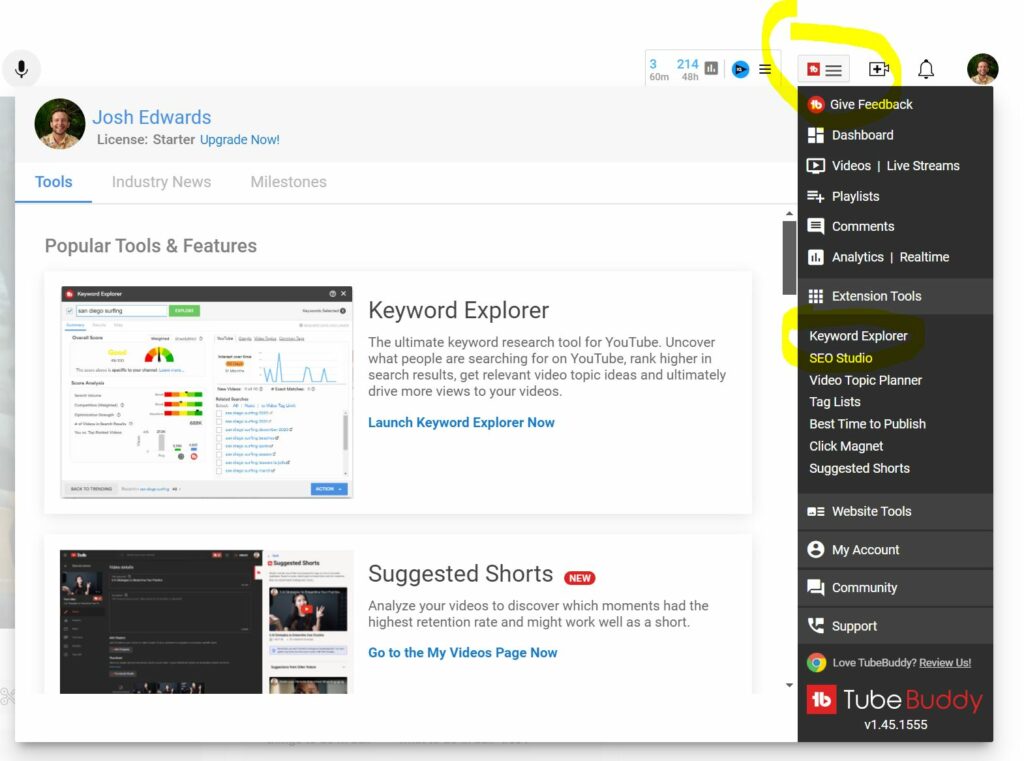
Now, you can search and identify the very best keywords for YouTube that relate to your video. For example, when I search “the ultimate Bali road trip” it ranks this as “excellent” with a score of 82/100. This is determined by search volume, competition and optimization strength. As you can see, you can dig further by upgrading the license to pro level. However, I’ve found that even the free version is pretty impressive.
You can spend some time experimenting with different phrases and keywords until you land on something that A) you’re happy with and B) performs well.
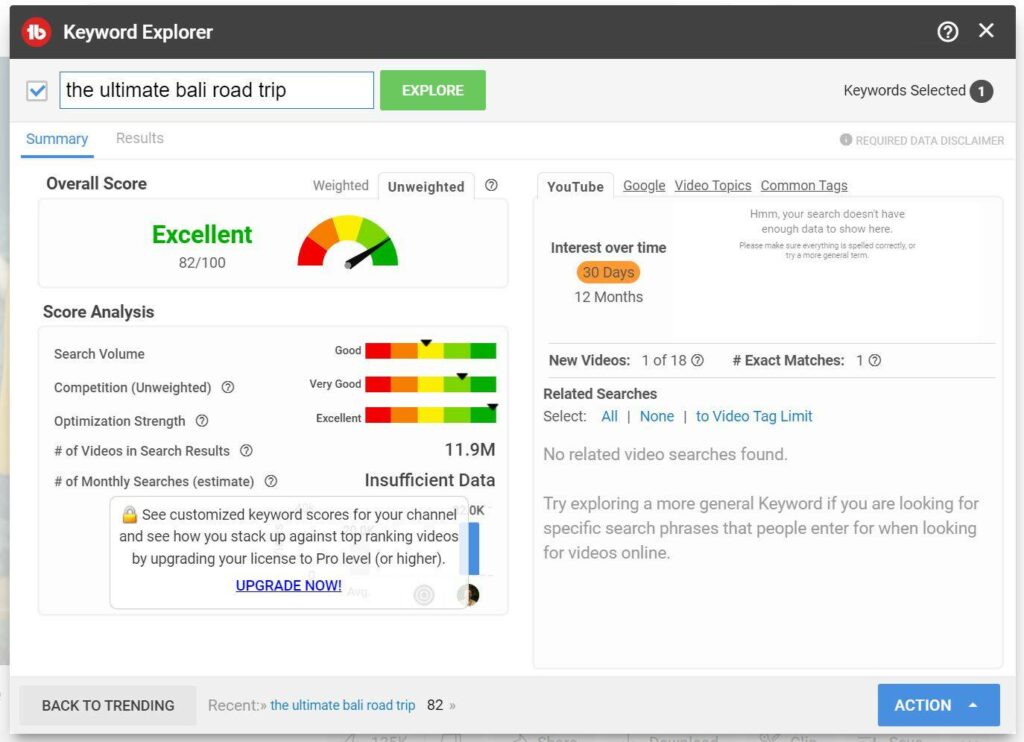
For faster results, you could use something like VidIQ’s keyword generator. You simply type in a keyword or phrase and it will generate related keywords that you can use for your own video tags.
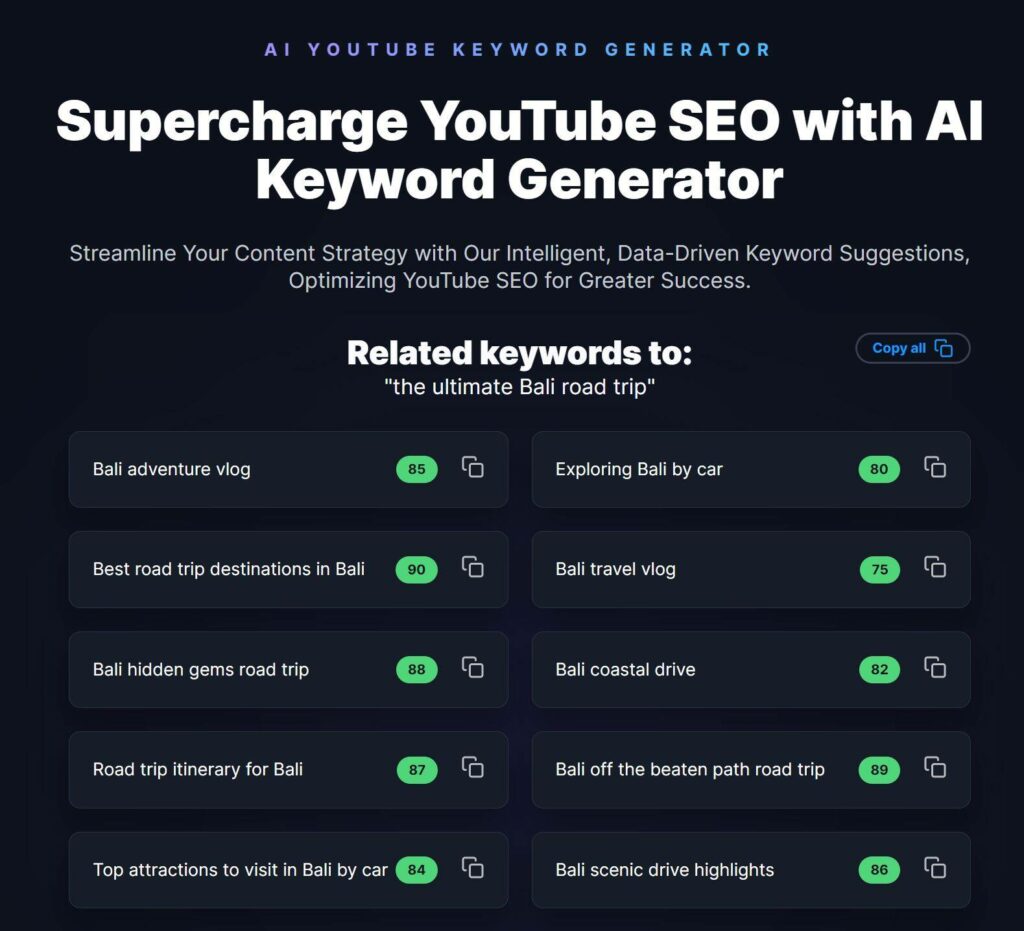
There are other keyword generators out there such as Ahrefs and KeywordTool.io but you will have to pay or subscribe to use these services to their full extent.
YouTube tag extractors
If you’re looking to simply extract the keywords from an existing video, there are plenty of easy ways to do that. You’ll notice when using both VidIQ and TubeBuddy plugins, there’s the option to copy the keywords with the click of a button.
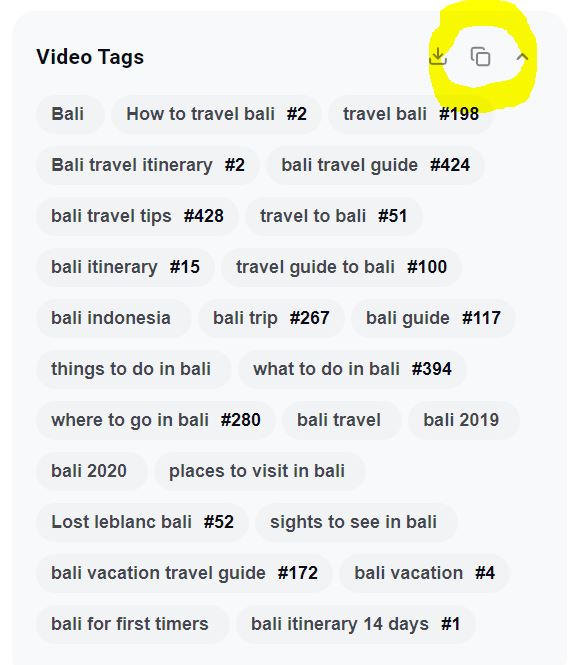
Alternatively, you can check out the YouTube tag extractor browser extension which serves exactly the same purpose – it instantly displays all the tags on any YouTube video and allows you to copy them with the click of a button.
Power your business’s creativity with Artlist Business
Best practices to write keyword tags
Here are a few top tips when it comes to writing the best keywords and YouTube tags.
Be specific
The more specific you are, the better. Remember that YouTube’s algorithm is using your keywords and tags to understand, categorize and surface your content to the relevant audience. If we’re uploading our video about road tripping Bali, the keyword “Bali” is okay, but a better, more specific keyword or tag would be phrases such as “the ultimate Bali road trip” or “road tripping around Bali”.
Use searchable terms
When writing keywords and tags, think like your audience – what would you be searching for in order to find the video you’re uploading? If you wouldn’t type it into the search bar, don’t list it as one of your keywords or tags.
Keep it relevant
While it can be tempting to use other keywords and tags that you know will generate a lot of clicks and views, don’t fall into this trap. Make sure that all of the keywords and tags you’re writing are relevant to the video you’re uploading. If you start clickbaiting, it will hurt you in the long run.
How to add YouTube tags to your videos
Once you’ve done your YouTube keyword search and landed on your select few keywords, it’s a simple case of implementing them into your YouTube video title. I may run with something like “Hiking an active volcano in Indonesia (epic adventure)” for the example I’ve been using. Alongside your title, you’ll also want to add your keywords into the YouTube video description. The YouTube video description is where you can mention a number of your relevant keywords and search tags – just ensure it’s all relevant and isn’t spam. YouTube will pick up on whether you’re “stuffing” your video description with random tags and keywords.
When it comes to adding YouTube tags, it’s a simple process.
- Begin by uploading your video. Navigate to the “create” button in the top right-hand corner of the YouTube homepage.
- As the video uploads, find the YouTube tag viewer in the “video details” section, below the video description and thumbnail options.

- Now begin adding your YouTube tags, entering a comma after each tag (as prompted).
- I would recommend adding your keywords first and then fleshing it out with several other search tags that remain relevant and appropriate to your video. You’ll notice that there’s a total character limit of 500 but remember, you don’t have to fill this out just for the sake of it. Only using a few niche-relevant search tags is fine and may work in your favor. Use common sense here – if it seems like a relevant video tag, add it. If it’s not one of your keywords for YouTube and bears no real relevance to the video? Leave it out.
Are your YouTube tags working?
There’s no certain way of seeing exactly how well your tags for YouTube are working, but there are plenty of indicators that can help you figure it out. If we remind ourselves that YouTube tags are keywords that describe your video and give it more context in order to help more people find your content, then we can say that a YouTube tag is working and performing well if
- The video ranks higher in the search results
- The video is getting more views
- The video’s watch time is longer
Remember, we can also use tools like TubeBuddy and VidIQ to see how well each tag is performing in its search ranking. If you have lots of rankings in the top 10 or 20, then it’s safe to say that your tags are working well!
YouTube Tags and hashtags – are they the same?
Wondering if there’s a difference between YouTube tags and YouTube hashtags? The answer is yes.
While tags for YouTube are used for relevancy in a YouTube search, hashtags are only used for a dedicated hashtag search. For example, if I search “Bali road trip”, then tags will be utilized to offer me up relevant videos to this search term. However, if I search #BaliRoadTrip, then videos will be offered up which use the #BaliRoadTrip hashtag. It’s a subtle difference, but one that’s worth remembering.
Wrapping up
So, that’s your introduction to the world of YouTube keywords and tags for YouTube. Whether you’re looking into starting a YouTube channel or further along the line, knowing how to tag YouTube videos properly is a key skill. It can help you unlock more views and really grow your YouTube channel.
Now that you understand what a video tag is and the importance of the YouTube keyword search, it’s time to put it into practice. The only real way of knowing if your YouTube video tags and keywords are working is to experiment and analyze the YouTube metadata.
Furthermore, if you’ll looking at how else you can improve your channel, you’ll want to check out specifics such as how to make a YouTube banner, a YouTube channel trailer, the importance of YouTube cards, the YouTube end screen, as well as knowing how to create a YouTube playlist and how to make a YouTube intro. The trick to achieving YouTube success is in combining all of these different elements and skill sets. There’s a lot to master, but we’re with you every step of the way!
Josh Edwards is an accomplished filmmaker, industry writing veteran, storyteller based in Indonesia (by way of the UK), and industry writer in the Blade Ronner Media Writing Collective. He's passionate about travel and documents adventures and stories through his films.
Share this article
Did you find this article useful?
Related Posts
- By Daniela Bowker
- 7 MIN READ
- By Jessica Peterson
- 20 MIN READ
Latest Posts
- 17 Apr
- By Daniela Bowker
- 7 MIN READ
